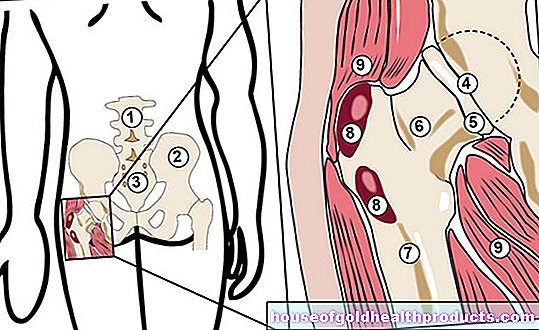Stable lateral position for adults
Carola Felchner is a freelance writer in the medical department and a certified training and nutrition advisor. She worked for various specialist magazines and online portals before becoming a freelance journalist in 2015. Before starting her internship, she studied translation and interpreting in Kempten and Munich.
More about the experts All content is checked by medical journalists.In the stable side position, the airways of an unconscious, still breathing person are kept free. To do this, the person affected is positioned so that their mouth is the lowest point. This allows vomit, saliva and blood in the mouth and throat to drain outwards. In addition, the head is overstretched a little to open the airways. Read here how to get someone into a stable lateral position and why there are now two versions of this first aid measure.

Stable lateral position: brief overview
- What is the stable side position? Leaning an unconscious person on the side so that they are as stable as possible and the airways remain free.
- This is how the stable side position works: Pull one hand of the patient over his chest and place it on his cheek, stand up one knee, pull the unconscious person into a side position so that the head rests on the hand and the bent knee supports the patient's position.
- In what cases? In people who are unconscious but still breathe on their own.
- Risks: Undetected damage such as broken bones or spinal column injuries can be aggravated by the rolling movement on the side (in an emergency, however, bring the patient into the stable lateral position!). Breathing is less easy to control in the stable side position. Therefore, sudden stopping of breathing may not be detected until too late.
Caution!
- There are now two versions of the (stable) side position. Neither is wrong, or both are better than doing nothing.
- If a spinal column injury is suspected, the person affected should, if possible, be brought into the stable side position by two helpers and with caution. The risk of suffocation (from one's own tongue, vomit, etc.) is to be rated higher than the risk of additional damage to the spine from rolling.
- Pregnant women should only be turned on their left side, as this does not impair the blood flow to the vena cava.
How does the stable side position work?
The stable side position is an important first aid measure for unconscious but breathing people:
If someone passes out, their muscles go slack. In the supine position, the tongue can tip into the throat and block the airways. Vomit, saliva, blood from a wound and foreign bodies can also get into the airways and block them - if you are unconscious, protective reflexes do not work, including reflex coughing if something gets into the airways.
By lying on the side, you can prevent an unconscious person from choking on a tongue that has fallen back, vomit, etc.
Stable lateral position: Instructions
This is how the classic version of the stable side position works:
- First, make an emergency call and put on medical gloves to avoid infections.
- Check whether the injured person might be conscious. To do this, you can speak to him and, if necessary, touch him gently.
- Check that the unconscious person is breathing. To do this, hold your ear over the patient's mouth and nose. Pay attention to breath sounds and breaths of air. Also, see if the person's chest rises and falls.
- If the unconscious is breathing, place him on his back.
- Then, kneel to the side of him and bend the leg that is closer to you.
- Now slide the hand on the same side under the unconscious man's bottom. If necessary, you can lift it up a little by applying light pressure just above the knee of the bent leg and gently pushing the person away from you.
- Grasp the farther arm of the unconscious man by the wrist and place it over the chest so that the hand is facing you.
- Turn the victim towards you by grasping and pulling by the shoulders and hips.
- Pull the arm that is now at the bottom out to the rear and support the hand of this arm on the back of the unconscious.
- Place the other hand under the person's head. Hyperextend his neck a little so that the airways are / remain open. You should also open your mouth slightly so that liquids can drain off.
- Align the hand that lies under the head of the unconscious so that the neck remains hyperextended even if you are not holding the head. Important: the mouth must be the lowest point of the body!
- Regularly check the person's breathing and pulse, and whether they are slowly recovering.
Stable side position: old and new in comparison
A second version of the stable side position has been taught in first aid courses for several years. It is only called "lateral position". What is new about this variant is that fewer steps have to be carried out. It is not the lower leg that is bent in the end position, but the upper one - at a 90-degree angle. The arm lying below is not positioned in the back of the unconscious person, but rather in front of his chest.
This new version was designed because it is easier to perform when one is not practicing or when the unconscious is very heavy. However, the old form of storage is more stable and can, if necessary, be retained or used on a stretcher.
Stable lateral position if a spinal injury is suspected
In the event of a serious fall or a traffic accident, there is always the suspicion that the unconscious person could have injured his or her spine. Moving it then basically carries the risk of causing further damage to the spine. If you are unconscious, however, the risk of choking on vomit, your own tongue, etc. is much more serious!
Therefore, in an emergency, even if you suspect a spinal injury, do not hesitate to bring the unconscious person into the stable side position. If you do this carefully and turn the patient properly, there will be little stress on his or her spine.
It is even better if the person concerned is brought into a stable lateral position by two helpers:
- A helper carefully prepares the patient to turn into the lateral position.
- The second helper kneels behind the unconscious person's head and holds the head in the extended axis of the spine without pulling - both during the preparations and when the patient is turned to the side (take the head with you when turning). This second helper also gives the command to turn.
Taking this cautious approach can reduce the risk of further spinal damage.
Stable lateral position for pregnant women
It can easily happen that expectant mothers upset. For example, when the child presses on the vena cava and the mother's blood pressure drops as a result. The stable side position can and should then also be used with pregnant women. However, as a first aider, you should definitely position the pregnant woman on her left side, as this will not reduce the blood flow via the vena cava. Also, place a pillow under the pregnant woman's waist. This allows the blood to flow back to the heart more easily.
Stable side position with the child
In principle, the stable side position can also be used with children. For small children, an alternative is the prone position with the head turned to one side. You can find out more about the stable side position and prone position for children in the article Stable side position for children.
When do I do the stable side position?
Use the stable side position for people who have lost consciousness but are still breathing independently.
If the unconscious person is no longer breathing, you must immediately turn him onto his back and start resuscitation!
Risks of the stable lateral position
According to a study from 2017, it is more difficult to assess breathing activity in an unconscious person in the stable side position. This can mean that first responders do not recognize it or recognize it too late when breathing stops. Life-saving resuscitation can be delayed.
Tags: foot care sleep organ systems





























